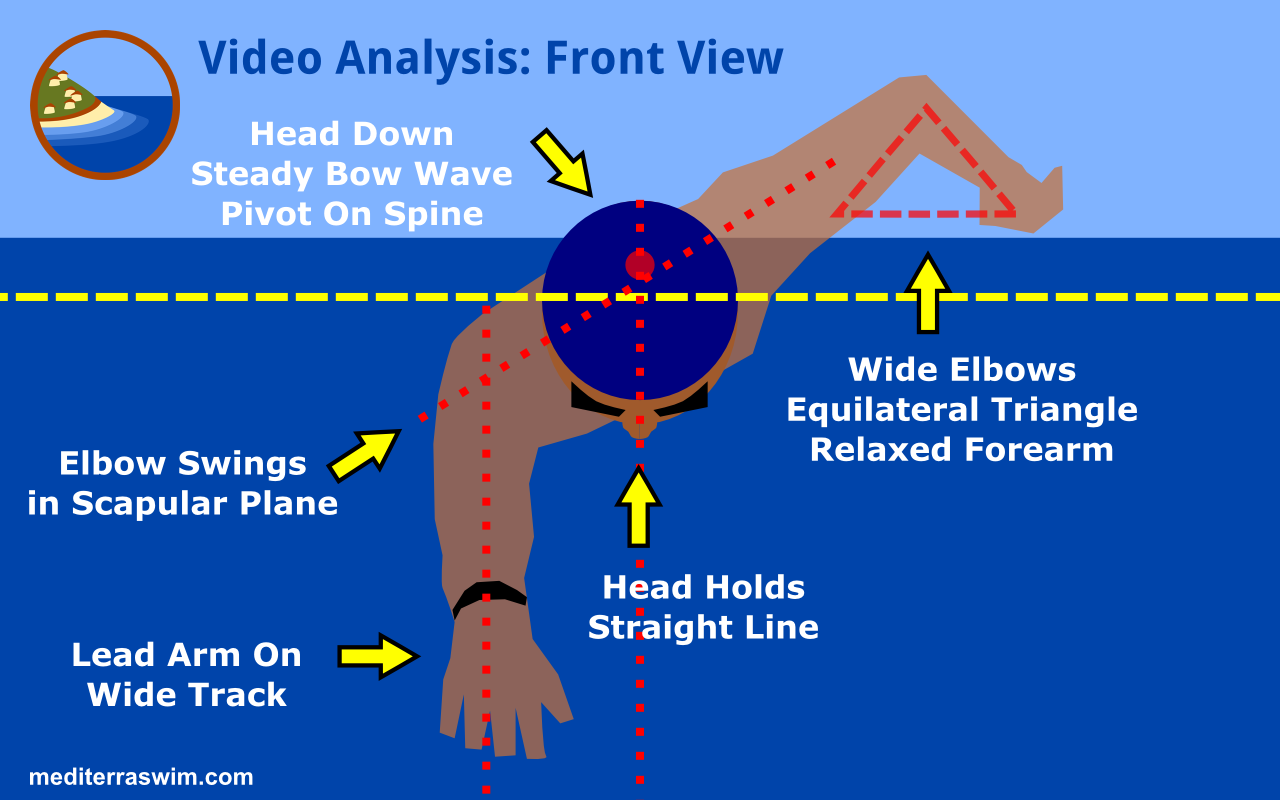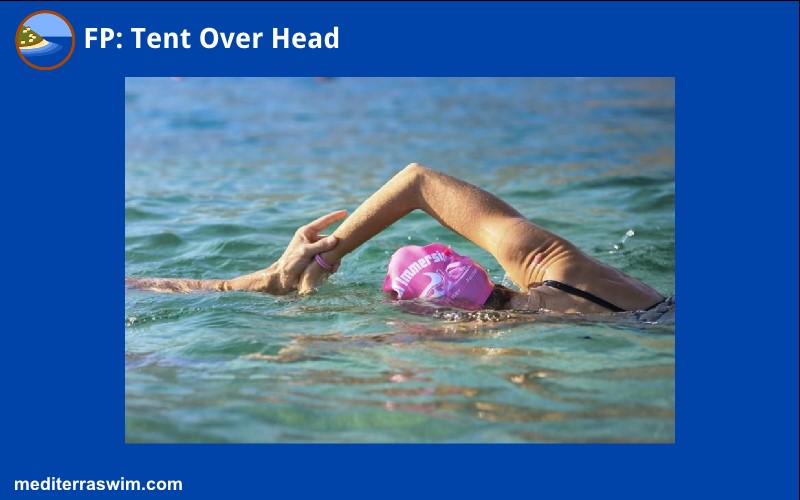Forums › Library › Swim Course Instructions › Send Force Forward Lesson
Please type your comments directly in the reply box - DO NOT copy/paste text from somewhere else into the reply boxes - this will also copy the code behind your copied text and publish that with your reply, making it impossible to read. Our apology for the inconvenience, but we don't see a convenient way of fixing this yet.
Tagged: drills, focal points, recovery, stability
-
AuthorPosts
-
February 27, 2018 at 17:48 #17514
Admin Mediterra
KeymasterIn the second freestyle technique lesson we work on building skills for the recovery arm swing and entry, while relying upon the skills for balance and streamline.
This lesson will build the third and fourth of our Four Essential Features of the freestyle stroke. These are explained in the following introductions:
And, here is the outline of the skills, drills and focal points, with links to video demonstrations of the drills. The following lists of activities and the lists of focal points may contain more items than you experienced in your lesson. The instructor will watch the time and your pace of learning and choose a certain sequence of activities and the few most relevant focal points for you to work with.
Drills
There are three sections to this whole Recovery movement that we need to construct:
- The exit – how the elbow and forearm and hand will leave the water
- The recovery swing – how the shoulder slides and arm swings from back to forward position
- The entry – how the arm is positioned to enter the water, and the pathway it follows to Skate
Recovery Swing and Entry Drills
These drills may be used for Exit, Recovery Swing and Entry skills:
- Standing rehearsal for recovery swing
- Swing Skate in slow-motion
- Standing rehearsal to create entry arm shape
- Swing Skate (swing to Entry Position and dip that arm it a few times)
- 2- Arm Slot To Skate
- Swing Switch in slow-motion, With Pauses
- Swing Switch in slow motion, Without Pauses
- Whole Stroke in normal motion
Swing Skate is where you hold Skate Position on one side and then practice swinging the recovery arm on the other side, in slow motion. There is no switching of the arms.
2-Arm Slot To Skate is where you are standing in shallow water, with one arm in entry position, the lead arm in front and that side leg forward. Then you fall forward over your leading leg, as the face touches the water, switch arms, and slide into Skate Position, and slide forward for a couple seconds.
Swing Switch is where you start in Skate, swing the recovery arm, then pause just a moment at entry, then switch the arms, slide into Skate, and repeat on the other side.
In Swing Switch, once you remove pauses, your stroke is continuous and smooth. Your movements are getting closer and closer to normal-speed, whole stroke swimming. As you gradually speed up the motion of the swing, you may also gradually lift that forearm out of the water (let the hand go wider to gain clearance), up to the point where your fingernails are still brushing the surface.
You may view demonstrations of these drills on the Video Tutorial page. You may also see snapshots of particular moments in these drill positions on the Freestyle Drill Resources page.
Focal Points
Exit Focal Points
- Swing elbow wide (swing out, not up behind the back)
- Elbow pulls the hand – hand is dragging behind
- Exit The Sleeve (pull forearm and hand out of water as if extracting from a jacket sleeve)
- No splash exit (the arm slips quietly out of the water)
Keep attention on the very moment before the elbow exits the water to begin the recovery swing. Pause there a moment, with elbow tucked against the waist, underwater, in order to override the instinct that pulls the elbow up in the air, behind your back. At the end of the underwater pull, as the elbow arrives beside the waist, that is the moment it needs to swing out wide from the side of the body rather than going high behind it. Once you set the elbow on the correct path, it will be much easier to keep it going in the right way, swinging wide beside the torso.
It is so important that you start the recovery swing in the best way, right from the exit moment. This sets the stage for the rest of the swing. If there is an error in how your arm exits the water, it will create error through the entire recovery swing. Be patient to get this exit moment down well.
Recovery Swing Focal Points
- Swing hand a bit wider (create equilateral triangle shape)
- Relaxed forearm and hand (‘rag doll arm’)
- Drag the knuckles (until the last moment, then swing hand forward)
- Push the Dot forward (dot on the elbow bone)
- Slide the shoulder all the way
- Keep shoulder internally rotated until last moment
- Elbow reaches shoulder line before wrist
- Keep fingertips in contact with surface (a.k.a. ‘dragonfly fingertips’)
- Swing The Bag
You may start practicing the recovery swing slowly, like a robot, which will keep your torso deep and the recovery arm mostly underwater in drill mode. But eventually, as the precise movement pattern becomes more familiar, more comfortable, you must speed up the motion so that it is fluid and fast enough to feel like the arm is truly swinging, light-weight, lifting off the torso for a moment.

Entry Focal Points
- Elbow swings forward in front of the head as far as comfortable
- Elbow high above ear (like a tent over the head)
- Feel the stretch in the back as you reach entry position
- Feel BOTH shoulders slide toward the ears, bracing the upper spine
- Forearm aiming straight ahead on track
- Forearm angling down steeply (45 degrees)
- Hand entry position across from opposite (lead arm) elbow)
- Ski jump shape entry path – Slide down to target depth and then extend forward
- Spear wrist through your target
You may examine other useful focal points for Recovery and Entry on the 101 Focal Points page.
Bringing the arm to this high elbow position is like building a wave to its peak height before the energy breaks and spills back into the water. It is so tempting to drop that elbow before it reaches its high position above and in front of the ear. Focusing on bringing the hand around will urge the elbow to drop, so let that hand drag behind the elbow until the last possible moment (that your shoulder joint comfortably allows). This will urge the elbow to climb higher as it comes forward, coming to its peak position higher than the head (seen in image below).

This high elbow sets up the forearm to aim straight ahead on its track, angled downward steeply into the water. Then you let gravity just pull this arm down into the water and begin extending underwater, following the Ski Jump path to the target.
Progression From Drill To Whole Stroke
You may follow this progression in Swing Switch Without Pauses to gradually raise the arm up above the surface while maintaining the qualities with focal points:
- Full (relaxed) forearm is submerged
- Half of forearm is submerged
- Watchband is submerged
- (soft) Fingers are submerged, dragging through the water
- Fingernails are just brushing the surface
As a useful permanent standard, you may keep your fingernails every so lightly brushing the surface during your recovery swing, all the way to entry. I like to call this ‘dragonfly fingertips’, like a dragonfly skimming the surface of a pond.
-
AuthorPosts
- You must be logged in to reply to this topic.
